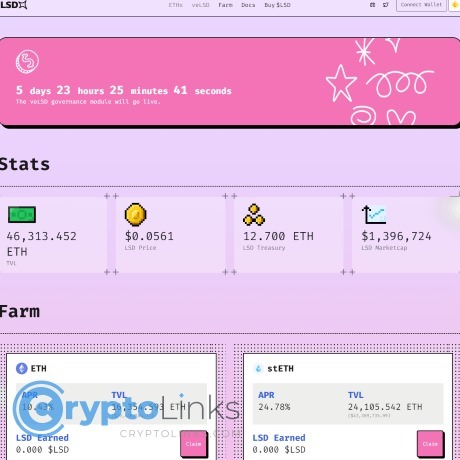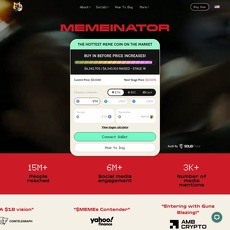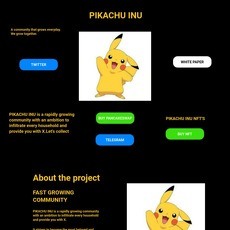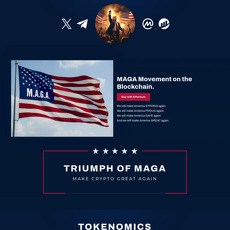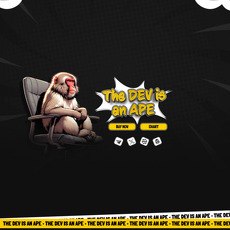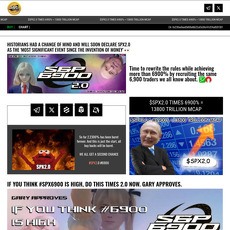LSDx Finance Review
LSDx Finance
lsdx.finance
If your website is on the scam list and you think that you are not a scammer, contact us. After you provide us with all the proof that you are in Crypto World with good intentions, we will delist you. Usually, you get in this category because you are hiding your team, you have a bad reputation(you are tricking, deceiving, scamming people), and you haven't got a written project whitepaper or is a shitty one....
Their Official site text:
LSDx - An ultra-liquid protocol for all LSD
Basic introduction of Ethereum Staking
Ethereum is one of the most popular and promising blockchains today. As a decentralized blockchain platform, Ethereum enables developers to build and deploy smart contracts and decentralized applications (DApps). The platform's flexibility and versatility have made it the go-to choice for a wide range of use cases, from decentralized finance (DeFi) to NFT and beyond.
However, as the Ethereum network has grown, it has faced some scalability issues, resulting in slow transaction times and high fees. This is where staking comes in. Staking is a process where users stake their Ethereum tokens to help secure the network and earn rewards in return. After Ethereum transitions to PoS, future L2 scaling plans will become simpler. By staking, users are essentially betting on the long-term success of Ethereum and its ability to continue to attract developers and users.
Staking can help Ethereum by incentivizing users to hold and lock up their tokens, which reduces the supply of tokens available on the market, thereby increasing their value. This, in turn, can help attract more investors and users to the platform, leading to further growth and development.
However, there are some limitations to staking. Once users have staked their tokens, they are locked up and cannot be transferred or traded until the staking period has ended. This means that users cannot access or use their staked funds during this time, which could be a disadvantage for those who need liquidity or want to sell their tokens during market fluctuations. Despite this limitation, staking remains a popular and effective way to support the growth and development of the Ethereum network.
Liquid Staking Derivatives (LSD)
In the Ethereum staking ecosystem, there are now various liquid staking derivatives (LSD) solutions available to users, including Lido, Rocketpool, and FraxETH. These solutions offer users a way to continue to benefit from their staked Ethereum by providing liquidity and allowing them to participate in the secondary market.
Lido is a decentralized staking service that allows users to stake their Ethereum tokens and receive liquid tokens $stETH in return, which can be used to participate in the DeFi ecosystem. Rocketpool is another decentralized staking service that allows users to pool their Ethereum tokens and stake them collectively, while receiving a liquid token $rETH in return that can be used for trading or investing. FraxETH, on the other hand, is a stablecoin that is backed by a basket of assets, including staked Ethereum, which provides users with a stable and liquid option for their staked funds.
While these solutions offer benefits to users, such as increased liquidity and flexibility, there are also drawbacks to consider. With so many LSD solutions available in the market, users may be confused about which one to choose, which can lead to fragmentation of liquidity across multiple platforms. Additionally, some users may be hesitant to trust these new solutions and prefer to stick to traditional staking methods.
Despite these challenges, the growth of the Ethereum staking ecosystem and the emergence of these LSD solutions demonstrate the increasing demand for more flexible and liquid staking options in the market.
What is LSDx?
LSDx is an ultra-liquid protocol for all LSD. We aims to optimize the financial value of liquid staking liquid staking derivatives (LSD) assets, addressing their limited liquidity and lack of diverse financial scenarios that hinder their connection with various DeFi protocols.
As the adoption of proof-of-stake (PoS) as a consensus mechanism is expanding across Ethereum and other layer1 networks, the demand for LSD assets is increasing. However, the current liquidity of LSD assets is relatively scarce, which limits their potential for broader financial applications.
LSDx seeks to establish a protocol that caters specifically to LSD assets, enabling them to unlock greater liquidity and a wider range of financial scenarios, while delivering higher underlying returns. By enhancing the value proposition of LSD assets, LSDx is committed to promoting the success of LSD projects and promoting their visibility within the crypto ecosystem.
Why we need LSDx?
Currently, the LSD narrative has the following issues:
Asset Quality
One of the biggest challenges facing LSDs is the quality of the underlying assets. Currently, there are several different types of LSD assets available, each with their own issuer and mechanism. This has led to a lack of standardization and transparency in the market, making it difficult for investors to distinguish between high-quality assets and low-quality assets. To address this issue, LSDx will introduce a set of evaluation criteria based on LSD assets and screen all LSD assets in the current market, ultimately selecting assets with excellent fundamentals to support.
Liquidity
Another major challenge facing LSDs is liquidity. Currently, LSD assets are primarily traded on decentralized exchanges (DEXs), such as Uniswap and Curve. However, these exchanges are not optimized for LSD trading, and liquidity is often dispersed across multiple platforms, leading to high slippage and low trading volumes. To address this issue, liquidity providers need to develop more specialized solutions for LSD trading. This could include the creation of dedicated LSD DEXs, the use of liquidity pools, and the development of more sophisticated market-making algorithms. We believe that LSD assets have tokens with similar intrinsic logic and value, so a more efficient, low-slippage, and low-trading-loss way can be used to construct liquidity.
Limited Financial Scenarios
Despite their potential, LSDs are currently limited in their financial applications. Most LSD assets are currently used for trading, liquidity provision, and borrowing. This limits the potential use cases for LSDs and prevents them from being adopted more widely.
To address this issue, LSDx will develop more diverse financial products that leverage the unique properties of LSDs. This could include the creation of yield farming strategies, the development of new lending products, and the integration of LSDs into other DeFi protocols.
Homogenization of Returns
LSDs are currently facing a homogenization of returns. The rate of return for most LSD assets is is basically in the range of APR 4-6%, and there is little differentiation between assets with different staking periods or lock-up durations. This makes it difficult for investors to find attractive returns and limits the potential for value creation.
To address this issue, LSDx will build more sophisticated staking mechanisms that enable greater differentiation between assets. This could include the creation of staking pools with different lock-up periods or the use of more complex reward distribution models, so that users with different preferences for returns can obtain comfortable returns here.
UM (Ultrasound Money)
UM is a stablecoin based on LSD, which is collateralized by excess ETHx to ensure its value. In addition, holding UM can generate real-time ETH returns.
Mint UM
Users can mint UM by staking ETHx as collateral on LSDx. The minting fee is 0%, and the mint rate is up to 50%. This means that for every 2 USD worth of ETHx staked, a maximum of 1 UM can be minted. The excess ETHx serves as collateral to ensure the value of the UM stablecoin.
Liquidation
When the collateralization ratio reaches 110%, liquidation will be triggered, and a liquidator will perform the process. The liquidator will repay the debt first, and the remaining amount will be returned to the minter. This process ensures that UM remains stable and maintains its value.
Burn UM
Users can burn UM to withdraw staked ETHx. The burning fee is 1%. The process is straightforward, and corresponding amount of ETHx will be returned to the user once UM is burnt.
Holding Rewards
Holding UM generates rewards from the collateral ETHx used to mint the coin. All rewards are distributed in $LSD.
Potential Use Cases
UM aims to become a true super currency with multiple use cases. One of its potential uses is as a payment method. UM's price stability makes it an ideal medium of exchange, and its quick transaction speed makes it suitable for everyday payment.
UM can be used for lending purposes, where users can collateralize UM to borrow other cryptocurrencies or stablecoins. The stability of UM reduces the risk for lenders, making it an attractive option for borrowers.
Furthermore, UM can serve as a liquidity provider in decentralized finance (DeFi) protocols. UM can be added to liquidity pools, which are used to facilitate trading in DeFi protocols, providing users with another option for liquidity provision.
UM can be used to create structured products, such as yield farming strategies or synthetic assets. These products can provide users with more sophisticated investment options and are made possible by UM's price stability and collateralization mechanism.
ETHx
ETHx is a basket of assets containing various types of Ethereum-based LSD, and it has built-in native LSD fast exchange. ETHx allows users to mint it with ETH, stETH, fraxETH or rETH, providing flexibility and convenience for users. It's designed to achieve the most optimal ratio based on liquidity, safety, interest, and DAO involvement.
The price of ETHx fluctuates based on a rebalancing mechanism that ensures that the token is always maintained at the most reasonable ratio of constituent tokens. Any deviation from the optimal ratio will result in either a bonus or a negative effect known as a 'slippage.' This ensures that the token is always maintaining its value and is the best possible representation of the underlying assets.
ETHx is designed to be a direct swap without needing to go through ETH first. This means that when users swap their assets on LSDx, they can do so with lower slippage rates compared to like Curve and Uniswap. This is because ETHx is a basket of ETH LSD tokens, providing a more optimal ratio of constituent tokens, which results in better liquidity and a lower slippage rate. Ultimately, ETHx and LSDx provide users with an efficient and cost-effective way to swap assets without compromising on security and efficiency.
Mint ETHx:
To provide liquidity to the platform, users can deposit any of the four assets: ETH/stETH/frxETH/rETH into the ETHx pool contract. In exchange, an corresponding amount of ETHx tokens are minted. The amount of ETHx minted is proportional to the amount of assets deposited and the current proportion of the three assets in the ETHx pool. By providing liquidity to the pool, users can earn rewards in the form of more ETHx tokens.
Providing assets that are in short supply in the pool will be considered as helping to replenish the scarce liquidity of ETHx, thus receiving more ETHx rewards. Conversely, providing assets that are in abundance in the pool will result in receiving less ETHx.
Redeem ETHx:
If a user wants to redeem ETHx, they can choose to redeem ETH/stETH/frxETH/rETH assets in proportion, or choose to redeem any single-sided asset. Redeeming a single-sided asset means that a transaction has occurred in the ETHx pool, and a 0.1% transaction fee will be charged.
LSD Swap:
We will open the LSD Swap function, allowing users to trade ETH/stETH/frxETH/rETH with each other through ETHx. A 0.1% service fee will be charged for each transaction, which will go into the LSDx treasury.
Support for more assets:
ETHx aims to support all high-quality ETH LSD assets. In the future, we will continue to support more assets to join ETHx, creating a larger mutual liquidity pool.
For specific rules on supporting new assets, please refer to the governance rules.
ETHx Earn:
ETHx Earn is a feature that allows users to stake ETHx to earn the platform token LSD. Users can choose the stake period, with longer pledge periods corresponding to higher yields.
Every 30 days, the platform will make a DAO decision on the reward pool of ETHx to adjust the token inflation.
For the first 30 days, ETHx Earn will provide 300,000 LSD as a daily reward.

